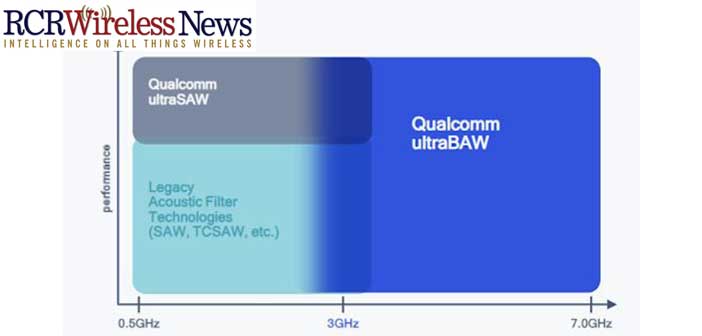03
Nov
With ultraBAW filter offering Qualcomm becomes a one-stop-shop for 5G device RF solutions

Qualcomm insists on calling its product offering a “Modem-RF System” highlighting the importance of RF in achieving excellent smartphone performance, as well as the tight integration between modem and RF subsystems that can take the performance even further.
Despite the rapid expansion of its RF product portfolio and business growth, there was a small but important gap in Qualcomm’s RF armor—BAW filters, which are important for spectrum bands higher than 2.5 GHz. With the announcement of ultraBAW filters, Qualcomm sealed that gap and become a de facto one-stop shop for the RF needs of 5G device OEMs.
RF – The least understood yet most important sub-system in 5G devices
One of the biggest reason RF is not talked about as much as the other parts of a smartphone such as GPU or CPU is that it is obscure, complex, and hard to understand. Yet, the very reason we can easily and seamlessly navigate our smartphones between different technologies, be it 3G, 4G, 5G, Wi-Fi, Bluetooth, or others, numerous spectrum bands including traditional Sub-5GHz bands or new mmWave bands, all with a single, sleek device, is because of the magic of phones’ RF subsystem.
RF subsystem is not monolithic. It is a collection of several different components each with specific a purpose. Typically, a smartphone would have a few high-power amplifiers (HPAs) and low noise amplifiers (LNAs), a variety of filters, lots of switches, as well as envelop tackers, antenna tuners, and more. The volume of these components and their complexity grew exponentially when we moved from 3G to 4G to 5G and are set to increase even more with the expansion of 5G. Accordingly, the importance and the value of RF grew in parallel. The share of RF in the total Bill of Material (BoM) of today’s 5G phones is rapidly growing. Hence RF has become a major growth driver for many companies. Qualcomm publicly sets itself a rather challenging target of achieving a 20% share of the total RF Serviceable Addressable Market (SAM), and it has claimed that it is on track to achieve or exceed that target by 2022.
Side note: For details more details on the Modem-RF system, please check out my Forbes article Differentiate 5G Smartphone Performance with The Right Modem and RF Strategy.
What is the significance of the ultraBAW announcement?
Historically RF market has been very fragmented. Typically, OEMs would get different components from a variety of vendors, trying to achieve a fine balance between performance, cost, and vendor diversity. Among the various RF components, some are more valuable than others. For example, switches are the least complex and are a volume driver, HPA and LNA are quite important for performance. Filters are altogether a different beast. Their importance has especially increased with the increase in the number of bands and operating frequencies. This 2015 chart from TDK presented by Mr. Christian Block nicely presents the various kinds of filters needed for different frequency bands. It is worth noting that Mr. Block is currently the head of Qualcomm’s RFFE business.

Surface Acoustic Wave (SAW) filters have been around for a long time. They are best suited for frequencies up to 2.5 GHz. Temperature Controlled – SAW (TC-SAW) filters, as the name suggests, are for high-temperature applications to maintain integrity and performance. Bulk Acoustic Wave (BAW) filters are needed to support frequencies higher than 2.5 GHz. Considering that many of the 5G bands including the 3.5GHz mid-band will be in the higher range, BAW filters are going to be a key part of the 5G device RF. So far, Broadcom almost had a monopoly on high-performance BAW filters, but, no more!
Qualcomm as part of the expansion of its RF portfolio had announced utraSAW filters in 2020. They claim that these filters perform far better than traditional SAW and TC-SAW filters, and even extend their utility up to 2.7GHz. Now with the announcement of ultraBAW filters, they will have solutions that cover any band up to 7 GHz, including cellular and Wi-Fi technologies. These will span applications across broadband, automotive, IoT, and other markets.


0 comments